 |
|
| (Information by Peter Kessler, with additional information from Late Palaeolithic and Mesolithic Settlement of the European North: Possible Linguistic Implications, Christian Carpelan, from The Magdalenian Settlement of Europe, Quaternary International Volumes 272-273 (2012), from The Horse, the Wheel, and Language: How Bronze-Age Riders from the Eurasian Steppes Shaped the Modern World, David W Anthony, from Proto-Indo-European Language and Society: Late Neolithic in the Pontic-Caspian Region, Rolf Noyer, from Asimov's Chronology of the World, Isaac Asimov, from Crimean Tatars, H B Paksoy, from The Mongol Empire: Genghis Khan: His Triumph and his Legacy, Peter Brent (Book Club Associates, 1976), from The Mongols: A Very Short Introduction, Morris Rossabi (Oxford University Press, 2012), from The History of the Medieval World: From the Conversion of Constantine to the First Crusade, Susan Wise Bauer (2010), from The Formation of Muscovy 1304-1613, Robert O Crummey, from History of the World: Volume 7, Arthur Mee, J A Hammerton, & Arthur D Innes (1907), and from External Links: The Palaeolithic of the Western Steppe Zone, Karol Szymczak (Reference Module in Social Sciences, 2023), and Maps of Neolithic & Bronze Age migrations around Europe (Eupedia), and Mesolithic Culture of Europe (PDF, Vidya Mitra Integrated E-Content Portal), and Early Mesolithic (Indo-European.eu), and Steppe Ancestry Chronology (Indo-European.eu).) |
|
| 480 BC |
The kingdom of the Bosporus is a Greek state which is created on the Kerch Strait side of Crimea, and extending into modern Ukraine. The kingdom�s major city is Panticapaeum (close to the modern city of Kerch), which is ruled by the Archaeanactid dynasty from this point onwards.  The Greek colony city of Panticapaeum (or Pantikapaion) was also known as Taurica, as the Tauri were the dominant native people in Crimea, and its ruins lay close to the city of Kerch The Greek colony city of Panticapaeum (or Pantikapaion) was also known as Taurica, as the Tauri were the dominant native people in Crimea, and its ruins lay close to the city of Kerch |
| c.121 - 88 BC |
Mithradates of Pontus proves to be a resourceful and powerful regional authority. Over the course of the first thirty years of his reign, he methodically captures and adds neighbouring kingdoms to his own realm, including Crimea, Paphlagonia, and Cappadocia, and makes Armenia an ally. Though opposed in theory by the Romans, little is done due mainly to Roman wars in Africa, continuing social disorder, and the crisis of the Germanic invasions by the Cimbri and Teutones. |
| 63 - 47 BC |
Pontus becomes a Roman province through Pompey, although some areas become principalities and free cities which are not absorbed into the empire until between 7 BC and AD 63. Upon Pompey's fall in 49 BC, Pharnaces, newly resurgent king of a reduced Pontus and Cimmerian Bosporus, takes advantage of Julius Caesar being occupied in Egypt, and reduces [ Kolkis](../KingListsEurope/EasternGeorgia.htm#Kingdom of Egrisi), Armenia, and part of Cappadocia. 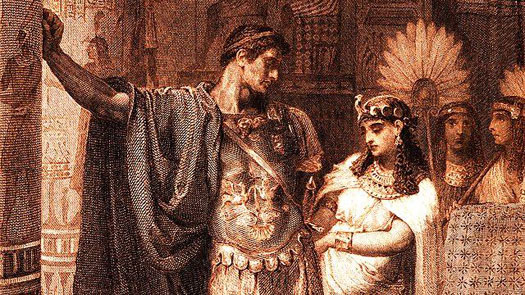 The last independent Hellenic ruler of ancient Egypt, Cleopatra VIII is perhaps one of history's best-known figures, thanks to her involvement in Rome's affairs in the lead up to the formation of the empire, and her two great romantic match-ups, with Julius Caesar and Marc Antony The last independent Hellenic ruler of ancient Egypt, Cleopatra VIII is perhaps one of history's best-known figures, thanks to her involvement in Rome's affairs in the lead up to the formation of the empire, and her two great romantic match-ups, with Julius Caesar and Marc Antony |
When the Roman ships are returning home from the region in 49 BC, some are cast onto the Tauric coastline of what is now Crimea. To a man the shipwrecked Romans are wiped out by the hostile Tauri there. Pharnaces' glory is brief, however. As part of his mopping-up operations after Pompey's fall, Caesar marches personally into Anatolia in 47 BC and defeats Pontus at the Battle of Zela (now in Tokat Province in northern central Turkey). Pharnaces' army is routed and he himself flees back to the Bosporan kingdom where he is assassinated by his own ambitious son-in-law, Asander. The Bosporan kingdom is briefly controlled by Pharnaces' daughter and her husband, Asander. 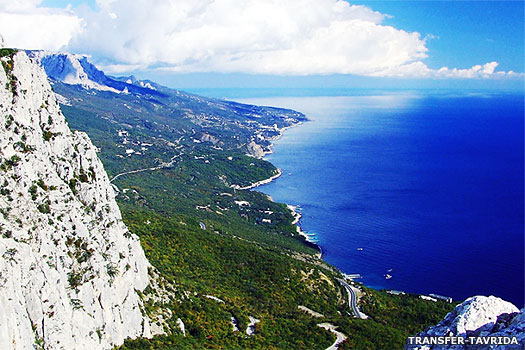 Crimea's southern coast largely consists of mountains and sharp descents towards the sea line, all of which was inhabited by the Tauri and then the Tauric Ostrogoths Crimea's southern coast largely consists of mountains and sharp descents towards the sea line, all of which was inhabited by the Tauri and then the Tauric Ostrogoths |
|
| AD 10 - 23 |
Two dedicatory inscriptions are known for King Aspurgus of the Cimmerian Bosporus which state that he makes the Scythians and Tauri his subjects. One of these inscriptions is dated precisely to AD 23, showing that this claimed subjugation takes place between AD 10-23. |
| c.200 - 225 |
Gepid and Goth migration is still apparently taking them across areas of central Willenberg Poland, including Galicia and Silesia. Archaeology shows that the Willenberg culture transfers south during this century which, having been associated with Germanic groups anyway, serves as evidence of the Goth migration. This merges with the indigenous Zarubintsy culture in Ukraine to form the Chernyakhiv culture. The main body of Goths remains around the Lake Maeotis region at the north-eastern corner of the Black Sea coast, but it seems that there is a good deal of straggling, or a process of migratory jumps and rests along the way by one or more other Goth groups. 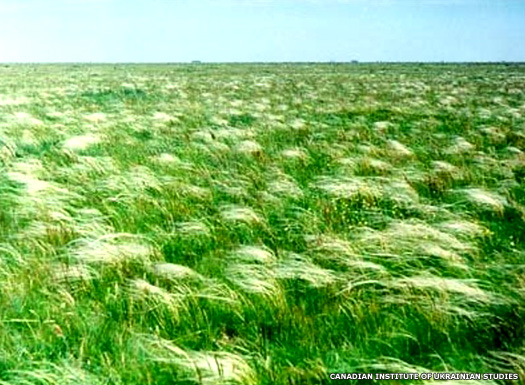 Migrating to the open steppeland of Ukraine (Scythia to the ancients, this photo being of Askania-Nova, immediately to the north of Crimea) also marked a return by the Goths to their Indo-European homeland of at least two thousand years previously, although they wouldn't have known anything about that Migrating to the open steppeland of Ukraine (Scythia to the ancients, this photo being of Askania-Nova, immediately to the north of Crimea) also marked a return by the Goths to their Indo-European homeland of at least two thousand years previously, although they wouldn't have known anything about that |
| 489 |
The Ostrogoths are now largely settled in Moesia, distancing them from their remaining kin who have remained further east, in the Crimean peninsula. These 'remainers' become known to history as the Tauric Ostrogoths. |
| 576 |
The desire of İstemi, viceroy of the Göktürk empire, to expand the empire ever farther westwards now leads him across the Kerch Strait and into Crimea. |
| 581 |
The death of [ Göktürk](../KingListsFarEast/AsiaEasternKhagans.htm#Eastern Kaghans) Khagan Tapo effectively ends the first dynasty of Göktürk khagans. However, the Western Göktürks continue to push westwards and now lay siege to the former Greek colony city of Chersonesus on the south-western tip of Crimea. Their cavalry continues to roam the Crimean steppe region until 590. 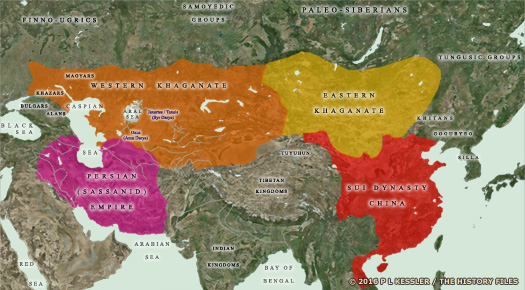 As was often the case with Central Asian states which had been created by horse-borne warriors on the sweeping steppelands, the Göktürk khaganate swiftly incorporated a vast stretch of territory in its westwards expansion, whilst being hemmed in by the powerful Chinese dynasties to the south-east and Siberia's uninviting tundra to the north (click or tap on map to view full sized) As was often the case with Central Asian states which had been created by horse-borne warriors on the sweeping steppelands, the Göktürk khaganate swiftly incorporated a vast stretch of territory in its westwards expansion, whilst being hemmed in by the powerful Chinese dynasties to the south-east and Siberia's uninviting tundra to the north (click or tap on map to view full sized) |
| c.632 - c.651 |
Qaghan Kubrat is the first to lay the foundations of a Bulgar military and tribal alliance. He forms a capital at Phanagoria on the Taman peninsula (an outcrop of territory on what is now the Russian side of the Strait of Kerch and the southern coast of the Sea of Azov, opposite Crimea). By this time the Altyn Ola horde has been absorbed, along with the Kutrigurs and Utigurs. Kubrat makes peace with the Eastern Roman empire and is awarded the title of patrician by Heraclius. Kubrat dies some time after 651 and his creation - Great Bulgaria - gradually falls apart. |
| c.690 |
A state emerges into history which is centred on Doros (today's Mangup Kale, around fifteen kilometres to the east of Sevastopol). This more-or-less autonomous state with Tauric Ostrogoths connections may or may not be a dependency of the Khazars and later conquerors, or it may be entirely independent, at least until the 780s.  This modern illustration of Qaghan Koubrat and his warrior sons show them at the height of their power, probably around the AD 650 point in time This modern illustration of Qaghan Koubrat and his warrior sons show them at the height of their power, probably around the AD 650 point in time |
| 1238 |
Batu Khan of the Golden Horde and Subedei devastate the already-subjugated (Mongol) Crimea and subdue Mordovia and the Kipchaks on the steppe areas. |
| 1282 - 1283 |
The power struggle between Toqta of the Golden Horde and Nogai Khan of the Nogai Horde flares up into open conflict, and Toqta is the eventual victor. Nogai's territories, which reach from (Mongol) Crimea and the southern Rus principalities to Wallachia, are divided by Toqta between Nogai's brother, Sareibugha, and his sons. |
| 1299 - 1300 |
The ongoing conflict between Pisa and Genoa reaches a head. Genoa has recently gained additional influence and power by extending its maritime empire to parts of (Mongol) Crimea (with the permission of the Golden Horde), allowing it to establish the colony of Kaffa there. 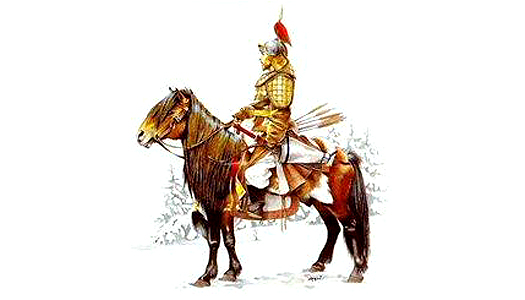 Batu Khan extended the borders of Mongol power into the lands of the Rus, bringing them under the domination of the Golden Horde for a century Batu Khan extended the borders of Mongol power into the lands of the Rus, bringing them under the domination of the Golden Horde for a century |
| It has also made a highly-profitable alliance with the resurgent Eastern Roman empire which directly impacts the ability of Pisa and Venice to compete commercially. In 1282, Pisa attempts to gain administrative and commercial control of Corsica when the giudice of Cinarca, Sinucello, revolts against Genoese dominance and requests support from Pisa. The situation quickly escalates from a Genoese blockade of Pisan trade on the island to full-scale war. |
|
| 1343 - 1345 |
Jani Beg leads a massive Crimean Tartar force against the Crimean port city of Kaffa. The assault turns into a siege which is lifted by a Genoese relief force. Two years later, Jani Beg returns, but the second attack against Kaffa is defeated by an outbreak of Black Plague. 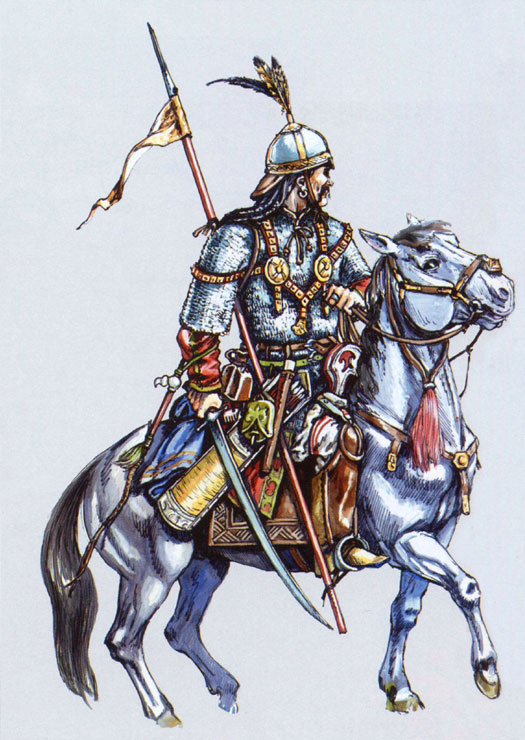 An illustration of a mounted Kipchack warrior, typical of the waves of westward migrants who swept in from the Kazak steppe during the eleventh and twelfth centuries, largely pushed that way by the sudden creation of the Mongol empire An illustration of a mounted Kipchack warrior, typical of the waves of westward migrants who swept in from the Kazak steppe during the eleventh and twelfth centuries, largely pushed that way by the sudden creation of the Mongol empire |
| 1367 |
Descended from the same Borjigin clan as Chingiz Khan, Mamai is a powerful military leader in the Golden Horde and also governor of the (Mongol) Crimean peninsula. Now he supports the claim by Abdullah Khan to rule the Blue Horde and firmly establishes himself as the true power behind the weakened throne. |
| 1378 - 1380 |
The Blue Horde is heavily defeated by the Muscovites under Demetrius Donski at the Battle of the River Vozha. Two years later the horde is defeated again by the Rus, at the Battle of Kulikovo. Mamai begins putting together a retaliatory force but is defeated by Toqtamish Khan of the White Horde in a battle on the banks of the River Kalka. Mamai flees to his base in (Mongol) Crimea where he is assassinated in Kaffa in the same year by the Genoese. 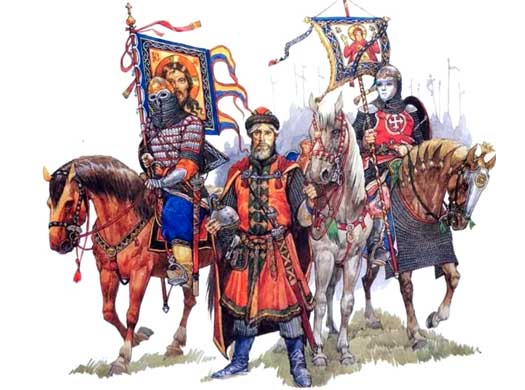 The Mongols maintained their dominance of the Rus with bloodletting where necessary, burning and destroying towns which stood against them and executing Prince Michael The Mongols maintained their dominance of the Rus with bloodletting where necessary, burning and destroying towns which stood against them and executing Prince Michael |
| 1427 |
Following the assassination of Baraq of the Golden Horde, his rival, Dawlat Berdi, establishes a base in (Mongol) Crimea, which he is able to defend even against an attempted invasion by Ulugh Muhammad in 1430. This defeat is claimed as the reason for the otherwise mysterious death of Vytautas the Great of [ Lithuania](EasternLithuania.htm#Grand Duchy of Lithuania) in his role as Ulugh's main supporter. However, despite the best attempts by Dawlat, he is never entirely able to defeat Hajji Giray, a powerful local khan who goes onto establish his own independence as the first ruler of the [Crimean](EasternCrimeanKhanate.htm#Mongol Khans) khanate. |
| 1783 - 1786 |
Despite having guaranteed its independence in 1774, the Russians under Catherine 'the Great' now formally annexe the khanate of [Crimea](EasternCrimeanKhanate.htm#Mongol Khans). This removes any possibility of Ottoman influence or domination. 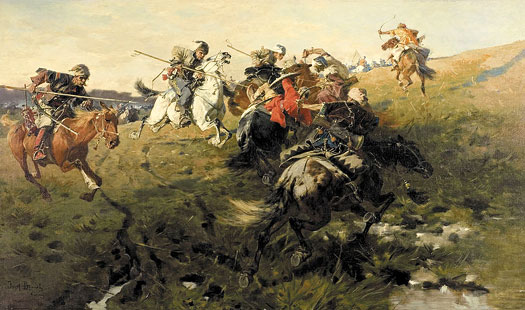 Tartars of the Crimean khanate fight Cossacks from the Ukrainian steppe, a scene which would be repeated many times over the course of the khanate's three hundred year-plus existence Tartars of the Crimean khanate fight Cossacks from the Ukrainian steppe, a scene which would be repeated many times over the course of the khanate's three hundred year-plus existence |
| In 1786 Catherine takes part in a procession in Crimea to celebrate the event, which itself sparks the Second Russo-Turkish War. Crimea remains a possession of the Russian empire and then the Soviet Socialist republic for two hundred and seventeen years before the break-up of the Soviet empire results in Crimea and Ukraine going their own way. |
|
| 1854 - 1856 |
Britain and [ France](../KingListsEurope/FranceFranks.htm#Second Empire) join the Ottoman empire in the Crimean War to halt Russian expansion. The war ends with the signing of the Treaty of Paris, a severe setback to Russian ambitions, although the Prime Minister of Great Britain is blamed for British failings in the war. 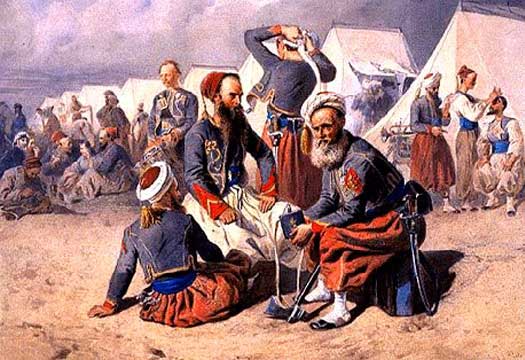 This illustration of French Zouaves (light infantry, generally drawn from North Africa) in Crimea was published in The Charleston Mercury on 21 November 1861 This illustration of French Zouaves (light infantry, generally drawn from North Africa) in Crimea was published in The Charleston Mercury on 21 November 1861 |
| 2013 - 2014 |
Mass protests in Kyiv over Ukraine's pro-Russian policy eventually force the collapse and flight of the Yanukovych government after four months of violent chaos. Moscow reacts to Ukraine's domestic turmoil by sending troops to annexe Crimea while stoking separatist sentiment in eastern Ukraine. However, the international reaction does nothing to change the situation, and Crimea remains in Russian hands. The Russian claim that Crimea belongs to it rather than Ukraine could easily be trumped by a Turkish claim that it had been a vassal territory of the Ottomans for far longer than it had a Russian one - three hundred years instead of a little over two hundred years.  The bailout agreement which included cheap gas and fifteen billion US dollars in loans which Russia offered to Ukraine on 17 December emboldened the government of President Viktor Yanukovych, but his victory would be short-lived - by only another four months, in fact The bailout agreement which included cheap gas and fifteen billion US dollars in loans which Russia offered to Ukraine on 17 December emboldened the government of President Viktor Yanukovych, but his victory would be short-lived - by only another four months, in fact |
 |
|

 The Greek colony city of Panticapaeum (or Pantikapaion) was also known as Taurica, as the Tauri were the dominant native people in Crimea, and its ruins lay close to the city of Kerch
The Greek colony city of Panticapaeum (or Pantikapaion) was also known as Taurica, as the Tauri were the dominant native people in Crimea, and its ruins lay close to the city of Kerch The last independent Hellenic ruler of ancient Egypt, Cleopatra VIII is perhaps one of history's best-known figures, thanks to her involvement in Rome's affairs in the lead up to the formation of the empire, and her two great romantic match-ups, with Julius Caesar and Marc Antony
The last independent Hellenic ruler of ancient Egypt, Cleopatra VIII is perhaps one of history's best-known figures, thanks to her involvement in Rome's affairs in the lead up to the formation of the empire, and her two great romantic match-ups, with Julius Caesar and Marc Antony Crimea's southern coast largely consists of mountains and sharp descents towards the sea line, all of which was inhabited by the Tauri and then the Tauric Ostrogoths
Crimea's southern coast largely consists of mountains and sharp descents towards the sea line, all of which was inhabited by the Tauri and then the Tauric Ostrogoths Migrating to the open steppeland of Ukraine (Scythia to the ancients, this photo being of Askania-Nova, immediately to the north of Crimea) also marked a return by the Goths to their Indo-European homeland of at least two thousand years previously, although they wouldn't have known anything about that
Migrating to the open steppeland of Ukraine (Scythia to the ancients, this photo being of Askania-Nova, immediately to the north of Crimea) also marked a return by the Goths to their Indo-European homeland of at least two thousand years previously, although they wouldn't have known anything about that As was often the case with Central Asian states which had been created by horse-borne warriors on the sweeping steppelands, the Göktürk khaganate swiftly incorporated a vast stretch of territory in its westwards expansion, whilst being hemmed in by the powerful Chinese dynasties to the south-east and Siberia's uninviting tundra to the north (click or tap on map to view full sized)
As was often the case with Central Asian states which had been created by horse-borne warriors on the sweeping steppelands, the Göktürk khaganate swiftly incorporated a vast stretch of territory in its westwards expansion, whilst being hemmed in by the powerful Chinese dynasties to the south-east and Siberia's uninviting tundra to the north (click or tap on map to view full sized) This modern illustration of Qaghan Koubrat and his warrior sons show them at the height of their power, probably around the AD 650 point in time
This modern illustration of Qaghan Koubrat and his warrior sons show them at the height of their power, probably around the AD 650 point in time Batu Khan extended the borders of Mongol power into the lands of the Rus, bringing them under the domination of the Golden Horde for a century
Batu Khan extended the borders of Mongol power into the lands of the Rus, bringing them under the domination of the Golden Horde for a century An illustration of a mounted Kipchack warrior, typical of the waves of westward migrants who swept in from the Kazak steppe during the eleventh and twelfth centuries, largely pushed that way by the sudden creation of the Mongol empire
An illustration of a mounted Kipchack warrior, typical of the waves of westward migrants who swept in from the Kazak steppe during the eleventh and twelfth centuries, largely pushed that way by the sudden creation of the Mongol empire The Mongols maintained their dominance of the Rus with bloodletting where necessary, burning and destroying towns which stood against them and executing Prince Michael
The Mongols maintained their dominance of the Rus with bloodletting where necessary, burning and destroying towns which stood against them and executing Prince Michael Tartars of the Crimean khanate fight Cossacks from the Ukrainian steppe, a scene which would be repeated many times over the course of the khanate's three hundred year-plus existence
Tartars of the Crimean khanate fight Cossacks from the Ukrainian steppe, a scene which would be repeated many times over the course of the khanate's three hundred year-plus existence This illustration of French Zouaves (light infantry, generally drawn from North Africa) in Crimea was published in The Charleston Mercury on 21 November 1861
This illustration of French Zouaves (light infantry, generally drawn from North Africa) in Crimea was published in The Charleston Mercury on 21 November 1861 The bailout agreement which included cheap gas and fifteen billion US dollars in loans which Russia offered to Ukraine on 17 December emboldened the government of President Viktor Yanukovych, but his victory would be short-lived - by only another four months, in fact
The bailout agreement which included cheap gas and fifteen billion US dollars in loans which Russia offered to Ukraine on 17 December emboldened the government of President Viktor Yanukovych, but his victory would be short-lived - by only another four months, in fact